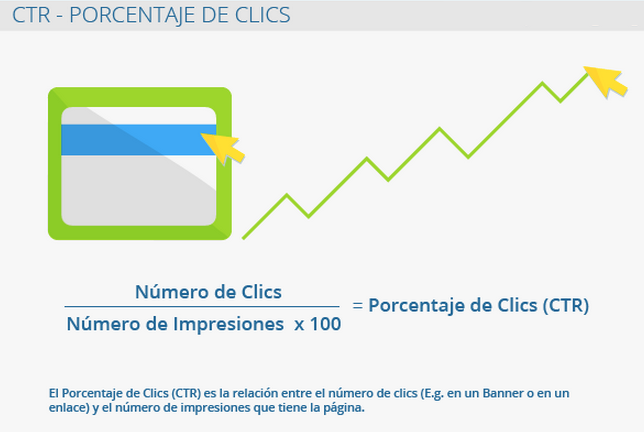The CTR (Click Through Rate), is he Click through rate. It comes from the link between the number of clicks a web portal receives and the number of Page Impressions (PI) it has in search engines. If a link with 1000 page impressions receives 23 clicks, its CTR is 2.3%.
CTR calculation
The CTR can be calculated in a very simple way using the following formula:
CTR = Number of Clicks / Number of impressions x 100
In the chapter "Author Stats" from the Google Webmaster Tool you can find information about the CTR of posts and blogs published online, and the data regarding the number of impressions and clicks can be seen in the section of "Search Requests" represented in diagrams. However, the exact value of the CTR must be calculated manually with the above formula. Currently there are SEO tools that offer CTR analysis.
CTR standards
There is no fixed standard value to review the CTR as it is highly dependent on the content. For example, Facebook ads generally feature a CTR 11%: a value considerably higher than that observed in traditional banners (0.5% or even lower). In 2010 a study carried out by the MediaMind announced a CTR 0.09% standard for banners. Apart from this, Germany, with 0.10%, is below the European average (0.12%): only 1 click is achieved per 1,000 impressions.
CTR correlation and conversion
Advertising campaigns should not have the main objective of increasing the CTR, in for example a 3%, since this percentage does not determine the success of a campaign, but the Conversion obtained.
Example
This happens specifically with the ads in the Google AdWords search engine: let's assume that a company launches an ad with 1,000 impressions and 40 users select the link, therefore, the company gets a CTR 4%, well above average. However, in the end, only 2 of the visitors make a purchase in the online store (one buys for a value of € 5 and the other for € 15). With a price per click of € 1.50 it is obvious that, despite the good CTR, the advertising campaign has been a failure as the costs (€ 60) are well above the sales.
IMPORTANT: in order to determine the success of an advertising campaign, CTR and conversion must always be analyzed together.
The CTR as a criterion of comparison
Despite being a key performance indicator (KPI), the CTR It is not optimal as a criterion of comparison since its value depends considerably on the format, campaign, brand, etc. Of course, the CTR It is a good mechanism for comparing the development of past advertising campaigns with the success of current ones.
Relevance for SEO
The term CTR It comes from the field of business promotion. In the SEO, the CTR is used to calculate:
- The number of visits from an affiliate banner
- The number of visits that carry out a purchase procedure (even if it is not completed)
East key performance indicator (KPI) provides information on the behavior of visitors. At the same time, in the SEO the CTR to review the number of clicks in search results, SERPs. This value provides information on how many times a search result has been chosen on the results pages. That is, if a keyword has been searched 500 times in a day and has been chosen 50 times, the CTR it will be from 10%. This value indicates that the ad format and description in the SERPs are interesting for users. The conversion obtained shows whether the offer announced on the web portal meets the expectations that the user has made with the ad found in the SERPs.
- When you have a low value of CTR measures need to be applied SEO. Some measures are:
Creation of advertisements adapted to different user groups (Eg based on age, gender or social fame), choose specialized websites (Eg expert forums), test different formats and content of advertisements (Eg size, format, image, etc. .) and use retargeting as a marketing technique.
Web links
- Click-through rate (CTR) support.google.com
- How to increase the CTR of your search results Blog 40defiebre.com
- How to get the most out of CTR and get more clicks from Google Blog mypositioningoweb.es




